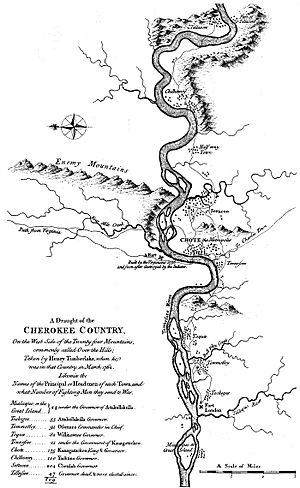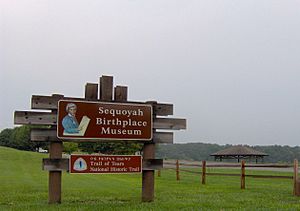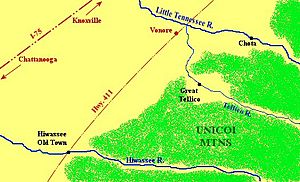Overhill Cherokee facts for kids

The Overhill Cherokee were a group of Cherokee people who lived in what is now Tennessee, in the Southeastern United States. This name was given to them by European traders and explorers in the 1700s. These Europeans came from British colonies along the Atlantic coast. They called them "Overhill" because they had to cross the Appalachian Mountains to reach their settlements.
These Cherokee towns were located along the lower Little Tennessee River, lower Tellico River, lower Hiwassee River, and upper Tennessee River. In the early 1700s, the Overhill towns became very important within the Cherokee Nation. They started to trade regularly with British colonists. Because they were far away, only brave traders and explorers made the difficult journey over the mountains to reach them. By the mid-1700s, both the British and French wanted to be friends with the Overhill towns. This was because these two European powers were fighting for control of North America and the valuable fur trade.
Later, during and after the American Revolutionary War (late 1700s and early 1800s), more European-American settlers moved west. This led to conflicts and the decline of the Overhill towns. The Cherokee were forced to give up most of their lands in this area. They signed treaties with the United States that were not good for them. For a while, they moved south and west, deeper into Georgia and Alabama, to get away from the settlers.
The Overhill town of Chota, in today's Monroe County, Tennessee, was like the capital of the entire Cherokee Nation for most of the 1700s. Another town, Tanasi, even gave its name to the state of Tennessee! Many famous Cherokee leaders grew up in Overhill towns. These include Attakullakulla, Oconostota, Nancy Ward, and Sequoyah.
What Happened to the Overhill Towns?
In the 1970s, most of the old Overhill town sites were covered by water. This happened when the Little Tennessee River was dammed as part of a big project by the Tennessee Valley Authority. Before the water rose, archaeologists worked hard to dig up and study these sites. They found most of the Overhill towns and thousands of artifacts. These discoveries gave them a lot of important information about the Cherokee and other indigenous peoples who lived there before them. They learned that different cultures had lived along the river for 12,000 years!
Where Were the Overhill Towns Located?
The Overhill settlements were mainly found around three rivers. These rivers are at the base of the Great Smoky Mountains and the Unicoi Mountains. Today, this area is in Monroe and Polk counties in Tennessee. The northernmost river, the Little Tennessee, had many important Overhill towns. These towns were located between modern-day Vonore and Calderwood Dam. Other key settlements were along the Hiwassee River, south of modern Etowah. There were also towns along the Tellico River, in modern Tellico Plains.
Native Americans mostly used the western side of the Great Smoky Mountains for hunting. However, early European explorers saw old, empty villages and temporary hunting camps. These were often found in the rich, bowl-shaped valleys (called coves) in the northern part of the mountains. They were also near where major streams joined together.
Famous Overhill Cherokee People

Many important Cherokee leaders came from the Overhill towns. Here are some of them:
- Moytoy of Tellico (born around 1687–died 1760) – He was a leader at Great Tellico.
- Old Tassel (Onitositaii) (born around 1700–died 1788) – He was a leader of Toqua.
- Ostenaco (born around 1700–died 1780) – He was a main chief of Tomotley.
- Attakullakulla (born around 1710–died 1777) – He was born in Chota.
- Oconostota (born around 1710–died 1783) – He was born and died in Chota.
- Jacob the Conjurer (active around 1730) – He was in Great Tellico.
- Dragging Canoe (born around 1738–died 1792) – He was born in Chota and later led the Chickamauga Cherokee.
- Nancy Ward (born around 1738–died 1824) – She was born in Chota and was a respected "Beloved Woman."
- John Watts (1753–1802) – He was the nephew of Old Tassel and became a leader after Dragging Canoe.
- Moytoy of Citico (1759–1761) – He started the Anglo-Cherokee War.
- Sequoyah (born around 1767–died 1843) – He created the Cherokee writing system (syllabary). He was born in Tuskegee.
- Savanukah – He took part in a Cherokee attack in 1776 and was a leader of the Overhills from 1780–1781.
- Abraham of Chilhowee (died 1788) – He led a Cherokee attack against Fort Watauga in 1776.


